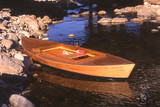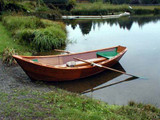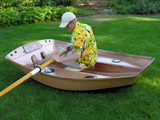DUCK BOAT PLANS INSTANT DOWNLOAD
For printed plans, click HERE
known variously as a scullboat, sneakboat, a poke boat, and a layout boat
Click HERE for an article about this boat from Outdoor Life Magazine
The duck boat is 11 feet 10 inches by 3 feet wide. The original traditional design was intended for two adults, or one adult with big dog and lots of duck decoys. Multiple layout and material options are discussed in the 35 page plans, including an open or partially decked-over version as shown.
Recently published in Outdoor Life, this is an updated and lightweight version of a market-hunter design. The prototype was built for a friends father, a retired Air Force Colonel and avid sportsman, who clipped an old hunting magazine describing the boat and brought it to our shop. The Colonel was a past president of the local Ducks Unlimited, and when we built this boat for him he was almost 80 years old.
This type of boat was known variously as a scullboat, sneakboat, a poke boat, and a layout boat when reclining or crouching to put "the sneak" on the birds. The shape is similar to the bateau design popular in the south, although this hull has slightly more rocker which adds stability when standing and makes it easier to "park" the boat against the shore or to nestle down in reeds and cattails.
We built the Colonel a simplified version in hardwood ply and epoxy. He could haul this lightweight in back of his truck, cartop it, or even let it hang out his station wagon. The boat also has a tough slippery graphite bottom so he could drag the hull like a sled across parking lots, up and down launch ramps and over logs--no lifting required.
With a bulkhead cut-out the boat will support two adults but only on calm and sheltered water. The cut-out allows one adult to extend legs into the bow section providing more room aft for a second person. Its ideal for a single hunter and a dog, an adult and a kid, or a hunter with a load of decoys. Getting comfortable in the boat for long periods requires a folding air mattress seat with a backrest. Rain gear is useful and also maybe a camo poncho to clamp over the cockpit coamings, and a hot thermos of coffee completes the package.
Row, paddle or scull? Traditional rowing with two oars is probably the most efficient muscle powered method for covering distance. Oars as short as four feet will work, but for getting there faster 6 foot oars are best and can still be stowed inside the boat. A double bladed paddle also works well and requires no oarlocks, and the boat may also be "sculled" with a single oar nestled in a transom notch or extended through a hole in the transom. The long keel provides directional stability when sculling,rowing or motoring and the smallest of electric motors will also push the hull right along.
In close to the birds, hunters would crouch or lay down and disguise the boat with netting, limbs and branches, and drifting close to a raft of ducks these boats are sometimes propelled with ping-pong paddles to prevent spooking the birds. Crafty hunters brag of sculling right through a raft of ducks.
The cockpit can be made smaller for more weather protection or larger for easy access, and the cockpit coamings can be enlarged to suit or eliminated completely. Hinged or screw-out hatches may be added as required and sealed flotation compartments can be used for dry storage and to provide emergency flotation should the boat be accidently swamped.
Building the boat is straightforward using epoxy and plywood, and the hull can be as light as 50 pounds, which makes it an easy cartopper. The plans are written for amateurs and first-timers and contain sketches, photos, materials sources, builders tips and a discussion of options to modify and customize the boat.
Comments from builders
... my grandfather remembers his father in Mississippi owning a similar boat. It was cypress, plank on frame construction, long before the days of plywood, and weighed almost 200 pounds. They used to go out and set traps and hunt in the boat and he remembers rowing the boat home with a big load of ducks and even some muskrats. Vern Aubuchon. Atlanta
**********
January 2009 Paul... The plans worked well for me and I did use that graphite on the bottom because we often drag the boat a quarter mile from the parking lot over a trail to get to one of the wetlands fed by a shallow stream. I'm an avid duck and goose hunter and we just pile brush or branches over the motor and around the cockpit and float around. I sometimes take my 10 year old but its hard for him to stay still and quiet for very long. Those high coamings really come in handy and work better than I expected, and thanks for all the email advice and ideas. George Maas. Alabama
**********
... we built it light with epoxy and that hardwood ply you suggested and it cartops at 55 pounds. My son built most of the boat in his high school shop class and we brought it home and finished it out. The kids like to fish on the lakes so for safety we left the 2 bulkhead compartments watertight with just a screw-out port for access through the deck. Julius Levine. New York
**********
... theres a lot of rocker in the bottom but when we load it settles down in the water and becomes real stable. These days I just mostly fish out of it and I even clamped a little motor on a transom mount to get me out and back if I'm in a hurry. I can't scull worth a hoot, so I just paddle or row if I don't use the motor. Next I'm installing foot controls for the motor inside the boat, mostly for bass fishing. Arthur Eben. Maine
**********
... I built plank-on-frame boats for years but this ply/epoxy is more like building model airplanes than boats. 2 years back I built your Montana Guide boat as a gift for my Dad, and now the duck boat is for myself. It's perfect for my flyfishing trips when I don't feel like walking the shorelines. Keith. Edmonton Alberta













